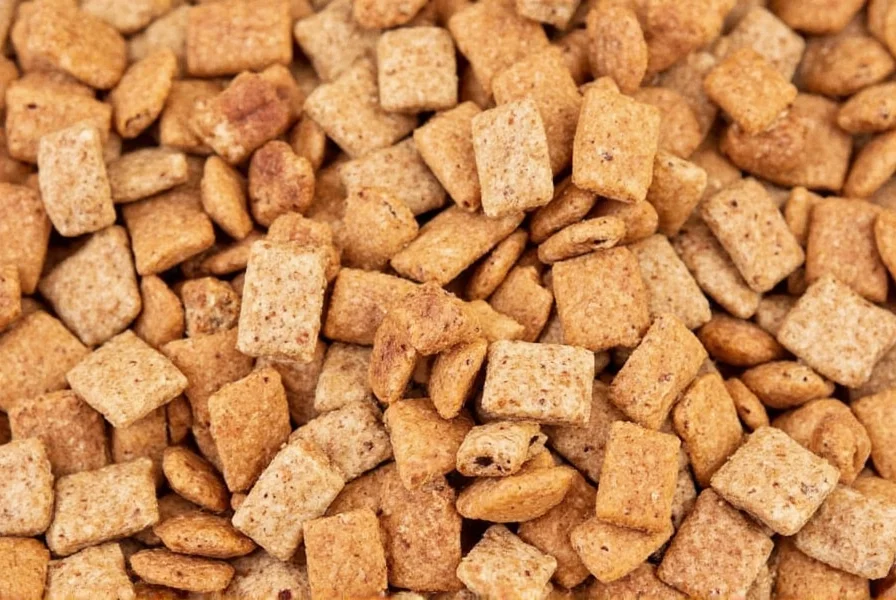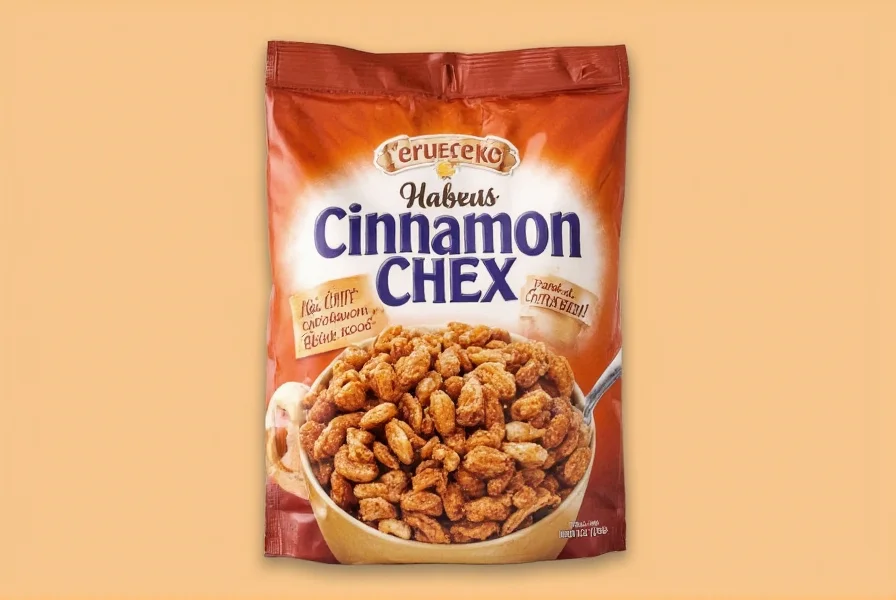Cinnamon Chex stands out in the cereal aisle as a distinctive rice-based option that delivers a warm cinnamon flavor without the heaviness of wheat-based alternatives. Created by General Mills and introduced in 1990, this cereal has maintained consistent popularity due to its unique texture and versatile flavor profile. What makes Cinnamon Chex particularly noteworthy is its rice foundation, which provides a lighter crunch compared to wheat-based cinnamon cereals while remaining naturally gluten-free—a significant advantage for consumers with dietary restrictions.
The cereal's manufacturing process involves puffing rice grains and coating them with a cinnamon-sugar mixture that creates its signature taste. This production method results in small, square-shaped pieces that maintain their crunch even when submerged in milk, unlike many other breakfast cereals that quickly become soggy. The texture remains consistent whether enjoyed with dairy milk, plant-based alternatives, or eaten dry as a snack.
| Nutrient | Per 1 Cup (52g) | % Daily Value |
|---|---|---|
| Calories | 200 | 10% |
| Total Fat | 1g | 1% |
| Sodium | 290mg | 13% |
| Total Carbohydrates | 45g | 16% |
| Dietary Fiber | 3g | 11% |
| Sugars | 14g | * |
| Protein | 2g | 4% |
| Iron | 9mg | 50% |
The complete cinnamon chex ingredients list reveals a straightforward composition: rice, sugar, cinnamon, salt, and natural flavor, fortified with essential vitamins and minerals including iron, zinc, and B vitamins. Unlike some competing products, Cinnamon Chex contains no high-fructose corn syrup, using regular sugar as its primary sweetener. The cereal's nutrition facts show it provides 200 calories per 1-cup serving with 14 grams of sugar—less than many comparable sweetened cereals but still significant enough to warrant mindful consumption.
When considering is cinnamon chex gluten free, consumers will find it's certified gluten-free by the Gluten-Free Certification Organization (GFCO). This certification makes it a reliable option for those with celiac disease or gluten sensitivity, unlike wheat-based alternatives such as Cinnamon Toast Crunch. The rice base eliminates gluten concerns while maintaining the satisfying crunch that cereal enthusiasts appreciate.
Cinnamon Chex vs cinnamon toast crunch reveals significant differences beyond just the base grain. While both offer cinnamon flavoring, Cinnamon Toast Crunch uses wheat and corn flour, making it unsuitable for gluten-free diets. Nutritionally, Cinnamon Toast Crunch contains slightly more sugar per serving (15g vs 14g) and more calories (160 vs 200 per cup, though serving sizes differ). The texture also varies, with Cinnamon Chex maintaining a lighter, airier crunch compared to the denser wheat-based alternative.
For those exploring cinnamon chex recipe ideas, the cereal's versatility extends far beyond breakfast. Its sturdy texture makes it excellent for creating homemade snacks like Cinnamon Chex mix (combining the cereal with pretzels, nuts, and melted chocolate), using it as a crunchy topping for yogurt parfaits, or even incorporating it into baked goods as a textural element. Many home bakers use crushed Cinnamon Chex as a coating for chicken or fish, providing a sweet-spicy crust that complements savory dishes.
Where to buy cinnamon chex includes most major grocery chains including Walmart, Target, Kroger, and regional supermarkets. The cereal typically retails between $3.50-$4.50 for a standard 12-ounce box, with larger economy sizes available at warehouse clubs. During seasonal periods like fall and winter holidays, stores often feature special promotions on Cinnamon Chex, particularly when marketing it for recipe use in holiday treats.
Consumer reception of Cinnamon Chex remains consistently positive, with many praising its balanced sweetness and reliable crunch. Longtime fans appreciate that the cereal has maintained its original recipe with minimal changes since its introduction. Some nutrition-conscious consumers note that while it's not a health food, it offers a reasonable compromise between taste and nutritional value when compared to other sweetened breakfast options.

For parents seeking breakfast options that children enjoy while providing some nutritional value, Cinnamon Chex presents a viable choice. The cereal's iron fortification helps address common nutrient gaps in children's diets, while its moderate sugar content falls below many competing children's cereals. When served with milk, it contributes to daily calcium intake, making it a more balanced morning option than many alternatives.
Understanding the complete cinnamon chex nutrition facts helps consumers make informed choices. Each serving provides 50% of the daily value for iron, 10% for zinc, and significant amounts of B vitamins including thiamin, riboflavin, niacin, and folic acid. While the sugar content warrants attention, the cereal's fortification profile and gluten-free status make it a practical choice for many households with diverse dietary needs.
Is Cinnamon Chex suitable for people with celiac disease?
Yes, Cinnamon Chex is certified gluten-free by the Gluten-Free Certification Organization (GFCO) and manufactured in dedicated gluten-free facilities, making it safe for people with celiac disease or gluten sensitivity.
How does Cinnamon Chex compare to Honey Nut Chex?
While both are rice-based cereals from the Chex family, Cinnamon Chex features a warm cinnamon flavor with 14g of sugar per serving, whereas Honey Nut Chex has a honey-nut flavor profile with 15g of sugar. Cinnamon Chex has slightly more sodium but similar nutritional profiles otherwise.
Can Cinnamon Chex be part of a healthy diet?
Yes, when consumed in appropriate portions. Cinnamon Chex provides essential nutrients like iron and B vitamins while containing moderate sugar levels compared to other sweetened cereals. Pairing it with protein sources like milk or yogurt creates a more balanced meal.
What are some creative cinnamon chex recipe ideas beyond breakfast?
Popular uses include making Cinnamon Chex mix (with pretzels and melted chocolate), using crushed cereal as a crunchy topping for desserts, incorporating it into homemade energy bars, or using it as a coating for baked chicken for a sweet-savory crust.
Does Cinnamon Chex contain artificial flavors or colors?
No, Cinnamon Chex contains only natural flavoring and derives its color from the cinnamon and sugar coating. The ingredient list does not include artificial colors, high-fructose corn syrup, or artificial preservatives.
Frequently Asked Questions
Is Cinnamon Chex suitable for people with celiac disease?
Yes, Cinnamon Chex is certified gluten-free by the Gluten-Free Certification Organization (GFCO) and manufactured in dedicated gluten-free facilities, making it safe for people with celiac disease or gluten sensitivity.
How does Cinnamon Chex compare to Honey Nut Chex?
While both are rice-based cereals from the Chex family, Cinnamon Chex features a warm cinnamon flavor with 14g of sugar per serving, whereas Honey Nut Chex has a honey-nut flavor profile with 15g of sugar. Cinnamon Chex has slightly more sodium but similar nutritional profiles otherwise.
Can Cinnamon Chex be part of a healthy diet?
Yes, when consumed in appropriate portions. Cinnamon Chex provides essential nutrients like iron and B vitamins while containing moderate sugar levels compared to other sweetened cereals. Pairing it with protein sources like milk or yogurt creates a more balanced meal.
What are some creative cinnamon chex recipe ideas beyond breakfast?
Popular uses include making Cinnamon Chex mix (with pretzels and melted chocolate), using crushed cereal as a crunchy topping for desserts, incorporating it into homemade energy bars, or using it as a coating for baked chicken for a sweet-savory crust.
Does Cinnamon Chex contain artificial flavors or colors?
No, Cinnamon Chex contains only natural flavoring and derives its color from the cinnamon and sugar coating. The ingredient list does not include artificial colors, high-fructose corn syrup, or artificial preservatives.











 浙公网安备
33010002000092号
浙公网安备
33010002000092号 浙B2-20120091-4
浙B2-20120091-4